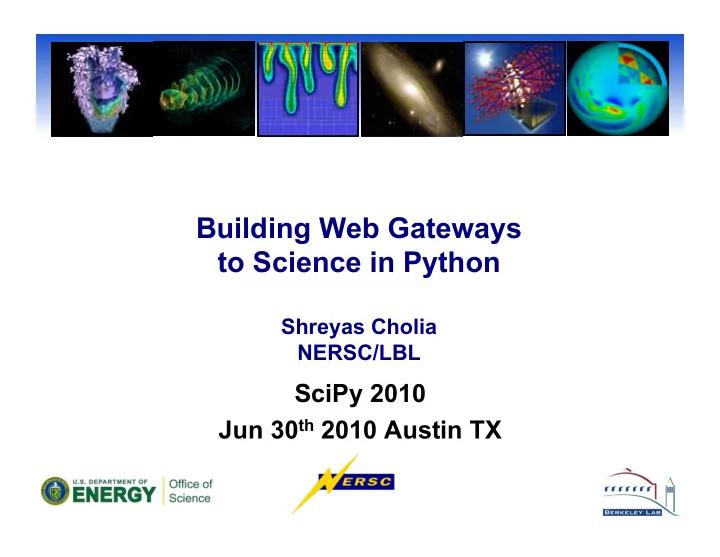

Building Web Gateways to Science in Python Shreyas Cholia NERSC/LBL SciPy 2010 Jun 30 th 2010 Austin TX
NERSC • National Energy Research Scientific Computing Center (NERSC) – Supercomputing facility at Berkeley Lab in Berkeley/Oakland CA • Mission – Accelerate the pace of scientific discovery by providing high performance computing, information, data, and communications services for all DOE Office of Science (SC) research.
Diversity of Users and Systems • Users have differing application requirements • Wide range of access patterns • Multiple systems to meet different user needs
Hide Complexity through Web Gateways • Users very comfortable with web paradigm. Now expect it for usability • Scientific Computing should be as easy online- banking X don’t want generic options/tools not applicable to your science X don’t want to deal with backend environment, UNIX CLI etc. • NERSC gateway services – host the gateway – assist in building the webapp – provide building blocks to science groups for their own apps.
NERSC Science Gateways NERSC Users www Science Gateway Science teams web server & General public REST Provides building blocks for science on the web: NEWT code Databases Active Data Tables Web toolkits start/stop batch jobs & OpenDAP manage and move data Compute-heavy CGIs host data services gridftp gram All through a web-browser NERSC using simple REST URLs HPC systems, Esnet, WAN NERSC Global Filesystem
Python bridges the Gap • Easy to use, expressive and productive programming language • Strong Scientific Library Support – SciPy, NumPy, Scientific.IO … • Rich web software frameworks – mod_wsgi + Django • Middleware layers to access data and computation – pyDAP, pyGlobus
Python based Web Gateways • DeepSky PTF Sky Survey – Image classification of Astronomical data – numpy for image processing • 20 th Century Re-Analysis – OpenDAP interface to perform sub-selection of climate data – PyDAP + Scientific.IO.NetCDF • NEWT – NERSC Web Toolkit – RESTful interface to supercomputing resources – Django
Deep Sky Goal: A gateway for selecting and manipulating telescope images (60 TB and growing) Impact: Discovered 36 supernovae in 6 nights of data during the commissioning of the PTF Survey. The scientific gateways allowed 15 collaborators from around the world to work non-stop for the first 24 hrs during this discovery phase
20 th Century Reanalysis • 20th Century Reanalysis contains objectively- analyzed 4-dimensional weather maps and their uncertainty for most of the 1900's. • Data stored at NERSC as NetCDF files (HDF5 format) • PyDAP service – provides OpenDAP protocol to access subsets of data over http • Specify URL with selection parameters – service returns dataset • Data parsed and subselected using python Scientific.IO.NetCDF interface
Access Resources using Web API • Encapsulate common patterns as building blocks for Science Gateways • Building block API should be very easy to invoke eg. via a simple web page – Every resource should be encapsulated as a URL with a simple set of associated actions – Full featured web applications using Javascript + HTML5 + REST • Science as a Service!
REST • Representational State Transfer • Every resource is represented by a unique http URL • Actions are defined by standard HTTP methods: GET, POST, PUT, DELETE • Lets you build an API that uses the language of HTTP • NERSC Web Toolkit (NEWT) - RESTful service that provides access to NERSC resources • NEWT combines NERSC database resources, Grid resources and other RESTful services under a single API
NEWT - NERSC Web Toolkit • Python Django Web Service – Upload/download files that makes HPC resources – Authentication available as http URLs – Submit jobs to • Build web applications supercomputer through REST API • No need for science team to – Accounting information learn underlying framework – View Batch Queue • User interacts with a web – Key Value Store application that exposes the necessary components of the underlying application
NEWT API examples VERB RESOURCE DESCRIPTION POST /resource/job/ submit POST data to queue on R, return job id get "fname" in "path" on R, copy it to GET /resource/file/path/fname apache server and download the file GET /user/username get user account info • Build web apps using pure HTML5/Javascript talking to NEWT service • Mixed Backend Resources (Globus, GPFS, CouchDB, SQLLite, other Web Services) completely transparent to user
Conclusions • The Python ecosystem allows us to create rich end-to-end interfaces to bring science to the end-user scientist over the web • Allows us to combine Web Layer (Django, PyDAP etc.) with Scientific Computing Layer (SciPy, NumPy, PyGlobus)
Info http://deepskyproject.org/ http://portal.nersc.gov/pydap/ http://portal.nersc.gov/newt/ Contact: Shreyas Cholia scholia@lbl.gov
Recommend
More recommend